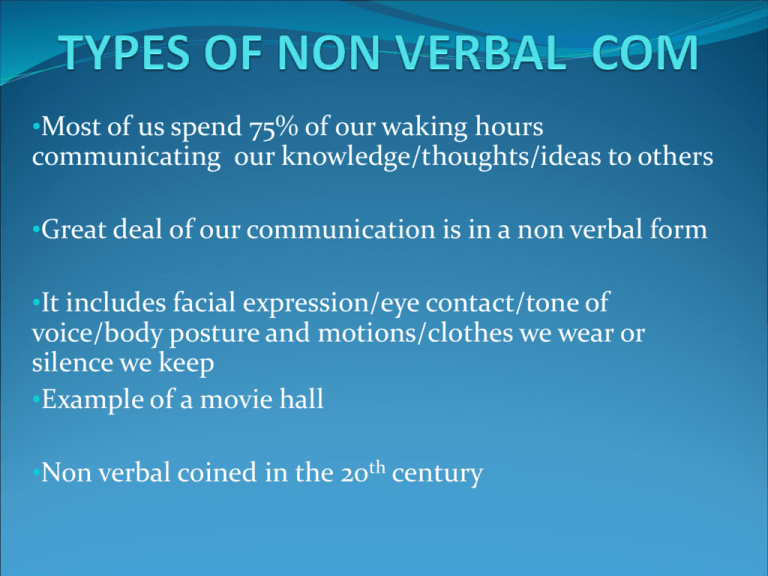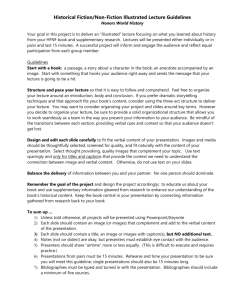Types of Non Verbal communication
advertisement

•Most of us spend 75% of our waking hours communicating our knowledge/thoughts/ideas to others •Great deal of our communication is in a non verbal form •It includes facial expression/eye contact/tone of voice/body posture and motions/clothes we wear or silence we keep •Example of a movie hall •Non verbal coined in the 20th century Contd The non verbal features include –communication through touch/smell/clothing/masks/vocal features such as -stress-speech rate-accent –volume There are so many definitions -it is the communication that uses non –linguistic means to convey the message Significance in Organizations Samuel Morse inventor of the first electric telegraph invented special alphabets of dots and dashes called Morse code that is still used today-to communicate words quickly over distances-other codes developed to conceal the meaning of he messages-such codes have played significant role in a variety of military battles Non verbal communication is nothing new “don’t watch a persons mouth but his fists” was the advice of Martin Luther the sixteenth century religious reformer We all know that the our earliest communication successfully took place without words -as babies we communicated with every body only through non verbal language-left behind but it has a profound subconscious effect As professional we find that we are ill-equipped to cope with contradictions between verbal & nonverbal messages that will come across in the organization We should know to use the non verbal clues- understanding /interpreting correcly Research has shown that between 70 & 90% of the entire communication spectrum is non verbal -You have to be aware of the different forms of non verbal communication you will encounter during negotiation/conferences -We continually send & receive non verbal messages -most of us are not aware -doctors/politicians/CEO are excellent non verbal communicators-some call it charisma others call it style If you are only aware of the senders verbal message you will likely miss the major portion of the overall communication Being aware of both non verbal & verbal messages will give you an important edge Skills in interpreting nonverbal communications will help you to collect useful information from others involved in the communication process An awareness of nonverbal communication may also prevent you from harming your own position by inadvertently sending non verbal signals that disclose confidential information or a weakness in your position Example-Different strokes for different folks-non verbal behaviours in different cultures can cause even greater problems than the ones related to language problems Non verbal can be unintentional/unconscious-makes it difficult to study-scientific study –sophisticated recording Non verbal cues are important in emotional communication -regarded as central to inter-personal relationships -Knowledge of non verbal communication is important for managers who serve as leaders of organizational teams for two reasons First-to function effectively as a team leader -team members project attitudes/feelings/personal needs /growth/achievement/recognition Second-how something is expressed may carry more significance and weight than what is saidaccompanied by a smile/frown/scolding voice or gentle voice Those sending the message should understand themselves better Silent language/nonverbal language important to management-leadership & decision making style -in job interviews and advertising Forms of Non Verbal Communication Conscious non verbal communication-Senders of conscious no verbal communication are aware of what they are doing /example giving a hug –message is friendship Subliminal Non Verbal communication-are communicated to the subconscious mind of the receiver/the uniform of a police /military-power Voluntary or involuntary messages-Counscious and subliminal messages can be transmitted voluntarily or involuntarily Involuntary non verbal communication-body language Voluntary non verbal communication-Non verbal communication an be controlled by a knowledgeable person-A person knows that people telling lies blink their eyes/so takes special care not to blink his eyes • Types of Non Verbal communication • It is a combination of cues and codes that work together to produce a certain meaning • There has to be integration of code and cues to give a meaning • Their functions -To create impression -To manage interaction -To send relational message -To send power and persuasion Kinesics Facial expression/posture/gesture Oculesics Eye contact Haptics The communication of touch Proxemics The communication of space & proximity Appearance and artifacts The physical characteristics/the attire/ac-cessories/perfume/makeup /jewellery etc Paralinguistics/vocalics Variation in pitch/speed/volume and pauses Chronemics The effects of time in communication Gestures-are observed actions -Ambiguous or unambiguous/pointing at water and mouth-wants to drink water -unnatural gestures-touching the body/playing with objects like clothing or pens/lip licking smiling too often -Beneficial gestures-performed with hands /arms and heads -arms/hands Conscious gestures-emblematic-gesture to sit down/propositional gesture-size/this big Spontaneous Gestures-unplanned /unselfconscious- gestures while speaking on the phone -Four types of spontaneous gestures -Iconic gestures may specify the manner in which an action is to be carried out -Metaphoric gestures-no physical form /meeting went on and on-hand indicating rolling motion -Deictics/locate in the physical space in front of the narrator/to demarcate or wave away -Beat gestures/small baton like movements /she talked first/I mean second accompanied by hand flicking down and then up Oculesics-is the way eyes are used during a communication exchange This may include eye contact or the avoidance of eye contact It is also associated with kinesic movements For example regulators often rely on both a kinesic component such as raising of an eye brow and an oculesic component such as looking into the eye of the other person to get a message It is a powerful form of non verbal communication Eye is the most noticeable non verbal behaviour that affects credibility-like old saying “eyes are your window to the world” Good Eye contact enables the sender of a message to determine whether the receiver is paying attention/showing respect/responding favourably/feeling distress Likewise the receiver ‘s perspective good eye contact reveals the speakers sincerity/confidence/truthfulness The following can serve as effective guidance on eye contact -If you have trouble staring someone in the look at someone in the eye look at something else on their face When speaking to a group look at everyone Look at people who are key decision makers or hold power Look at reactive listeners Do not look at the floor /scripts or anything that causes you tilt your head away from the receiver Do not look at bad listeners who may distract you Haptics-Touching is our first non verbal experience in life Through touch we learn to relate to people and objects Touching is critical to our sense of wellbeing We feel loved /cared for/respected/appreciated/emotionally supported with touch This form of non verbal communication also exists in other communication activities such as handshake/touching someone’s feet to show respect Haptic behaviour is used to indicate the degree of intimacy Divided into -Functional/professional -Social/polite -friendship/warmth -love /intimacy Touching patterns differ with children & adults/friends /strangers/subordinates and superiors in your work environment In Indian context many managers feel uncertain whether to touch or not –or how –to touch other people at work –especially when the other person is of the opposite sex Touch is an important way to convey warmth/comfort and reassurance can be ignored Proxemics-space /distance /territory are factors related to proxemic communication Space is the distance a person maintains between him/herself and his/her fellows and which he /she builds around him/her/in his/her home 7 office The ways in which a person uses space may be very significant to communication There are many different types of space that include ways in which we keep our home and office and how we maintain personal space Personal space /area around our bodies which we do not want to be intruded-personal space is your bubblethe invisible boundary Distance Relation Volume Close (8 in to 12 in) Highly personal/seldom in public Audible wishper/very confidential Near(12 in to 36 in) Many social interaction occur Indoors/soft voice Neutral(4.5 ft to 5 ft) Most social gatherings Outdoors/full voice and business transactions Public distance 5.5 ft to 8 ft) Business /social discourse/more formal Full voice with slight over loudness Across the room (8ft to 20 Used by ft) teachers/speakers at public gatherings Loud voice talking to a group Far distance (20ft and more Public address systems Public speaking by public figures Appearance and Artifacts-Potential employers/customers/colleagues are impressed by people who are trim/muscular and good in shape One’s physical appearance creates an image of the person in the same way the other non verbal message do People who look attractive are considered to be likable and persuasive/they have generally successful careers They are more credible more often than less attractive people You must always keep in mind the following in mind: Pay attention to good grooming /including a neat hairstyle/body hygiene/polished shoes and clean nails Invest in professional looking clothing and accessories Avoid flashy garments/clunky jewellery/garish make up and overpowering perfumes Ensure that you feel comfortable in your attire and that your accessories suit you before embarking on your business day Paralanguage/vocalics-You may have overheard two people arguing in the adjoining room even though you could not make out their words/their emotions and the fact they were arguing were explicit from the sound and tone of their voices Likewise you might have heard two of your colleagues talking to each other in a different language other than yours/though you could not understand the contents you would have had some idea about their talk or at least their feelings-excitement/delight/frustration/exhausation/boredom or grief-from the tone of their voice and other non verbal means Voice is an extraordinary human instrument People from different walks of life recognize that the human voice communicates something beyond language These effects are referred o by impressionistic descriptions /such as tone of voice/voice quality/manner of speaking/or the way they said it Para language refers to all vocally produced sound that is not a direct form of linguistic communication Paralanguage includes utterance that may have strong signifying traits but no semantic meaning This non lexical vocal communication may be considered a type of non verbal communication in its broadest sense as it can suggest many emotional nuances This category includes a number of sub categories: Tone(direct/commanding/loud/harsh/disguised/soft/ gentle/comforting/pleasing/volatile/scheming/sharp/ boisterous/rage/nasal etc -Inflection(spread-narrow)Stressing-I’ve got a BIG project/Stretching- I’ve got a B___i____g project/pausing-I’ve got ….a big project Pitch(high-Low) Intensity-(loud-soft0 Articulation(precise-imprecise) Rhythm-(smooth-jerky) Quality -Dysfluencies/pauses(silence-vocalized)-phwe/uh/oh/ -tempo/pacing(rapid-slow)speaking too quickly Chronemics-use of time as a message system- including punctuality/waiting time/time spent








